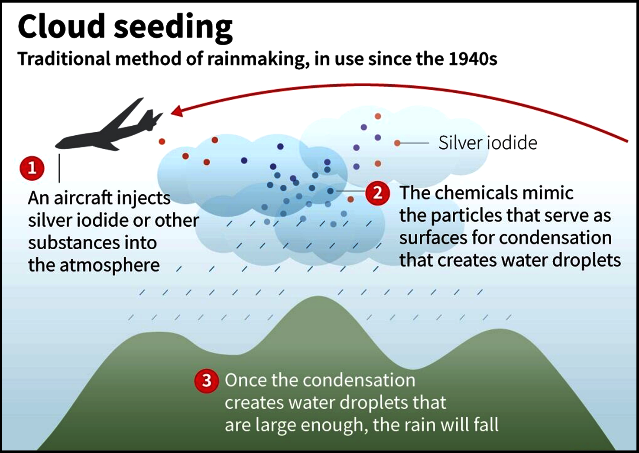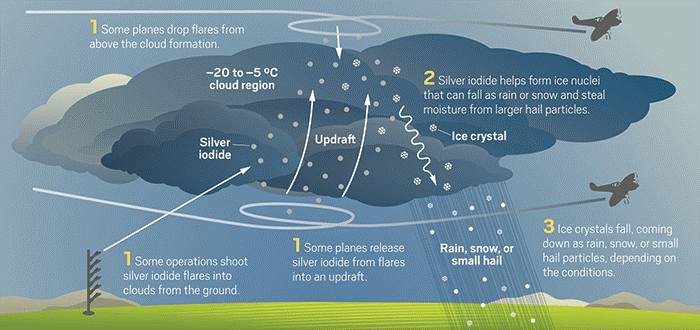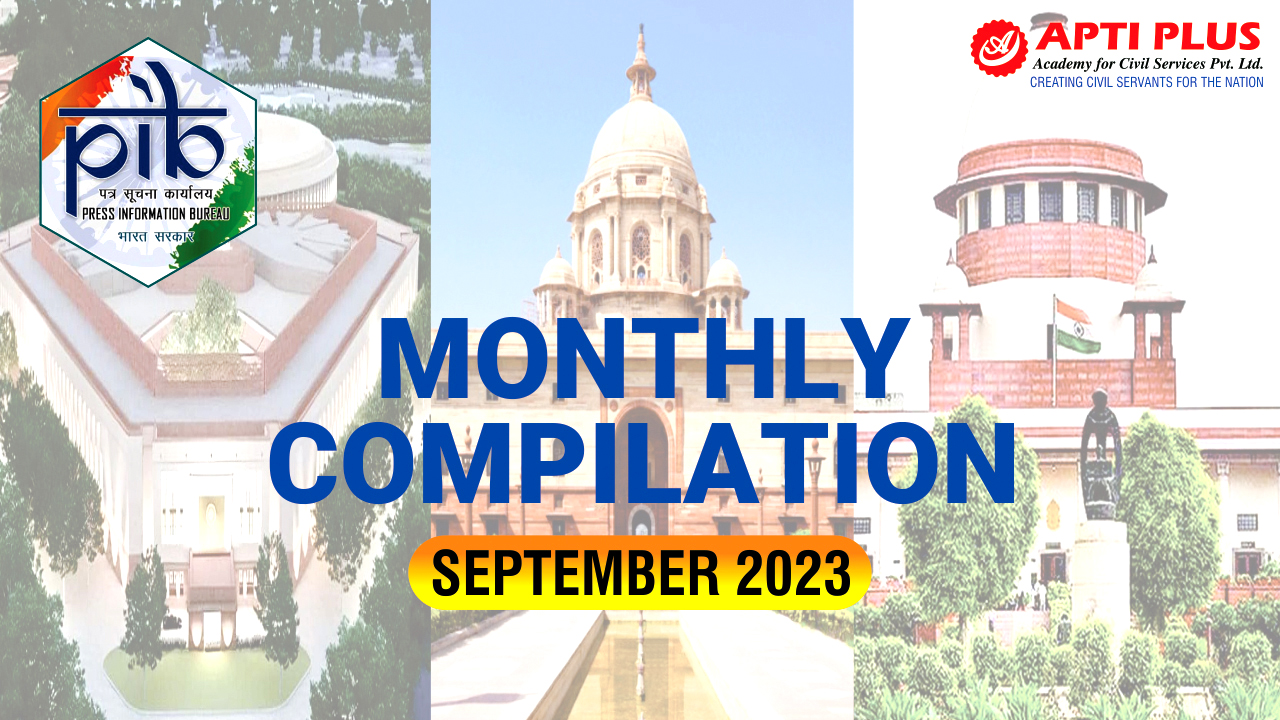Description

Disclaimer: Copyright infringement not intended.
Context
- The Delhi government said IIT-Kanpur could carry out the first pilot project for cloud seeding around November 20-21 to induce rain.
What is Cloud Seeding?
- Clouds are made up of tiny water droplets or ice crystals that form when water vapor in the atmosphere cools and condenses around a tiny particle of dust or salt floating in the atmosphere.
- Without these particles, known as condensation or ice nuclei, raindrops or snowflakes cannot form and precipitation will not occur.
- Cloud seeding is a weather modification technique that improves a cloud’s ability to produce rain or snow by introducing tiny ice nuclei into certain types of subfreezing clouds.
- These nuclei provide a base for snowflakes to form. After cloud seeding takes place, the newly formed snowflakes quickly grow and fall from the clouds back to the surface of the Earth, increasing snowpack and streamflow.

Pros of Cloud Seeding
- Rain Creation
- In the event that the amount of rain experienced in an area is inadequate, cloud seeding is the best way to consider to improve rainfall quantity. In many areas where precipitation hardly comes by, silver iodide can be introduced to induce rain formation.
- Rain is essential when it comes to keeping areas fertile and hydrated for farming purposes. Before cloud seeding, only a small portion of the moisture available in clouds was changed into precipitation that managed to reach the earth’s surface, this motivated engineers and scientists to avail options and possibilities of cloud seeding.
- Boosting of the Economy
- Agricultural production is important to the local economies of many regions around the world. Rain is important in achieving a proper harvest.
- With the right amount of rain, the local economy will benefit financially and there will be enough food to feed both the people and animals.
- Cloud seeding is also used in the betterment of living standards in an area with poor or dry climates.
Weather Regulation
- Some weather conditions could be dangerous to the environment if not properly managed.
- Cloud seeding provides an avenue for controlling prevailing weather conditions in different areas, although it is primarily used to improve the amount of rain; it can also limit precipitation which could develop into storms that cause mass destruction.
- Cloud seeding is utilized in keeping areas dry by increasing the precipitation. This reduces the cloud cover through evaporating the fog, reducing pollution and making it rain.

Makes Dry Places More Liveable
- Water plays a vital role in the sustenance of human life as it is one of the most basic needs in the environment. Arid areas usually have conditions that may be harsh in terms of food security and a conducive environment for living.
- Cloud seeding can bring rain, which makes the natural environment flourish and becomes more habitable. It could also lead to an increase in tourist attractions.
Reduction of crop damage
- Precipitation could present itself in an unwanted form. It could bring about a hailstorm that could damage or completely wipe out the crops. Cloud seeding changes the formation of storm clouds and makes them less of a threat to the crops.
Variety of methods of practice
- Cloud seeding can be done in three effective ways depending on the area that is being focused on. Static cloud seeding introduces silver iodide into the clouds in order to create a medium for the moisture to condense, dynamic cloud seeding is more compound than static as it aims to enhance vertical air currents and make more moisture to be produced by the clouds.
- The last one is hygroscopic cloud seeding, which introduces salts to the clouds at the base in blazes so that they can lead to high precipitation when water starts pouring from the clouds above them.
Use of ground-based machines
- With decent advancements in technology, cloud seeding in the modern-day does not only depend on airplanes but can also use independently operational machines. Several states have employed the use of machines that are strategically placed in high altitude areas where clouds potentially form. It brings about the same results as airplanes that drop silver iodide.
Geographically oriented
- Cloud seeding is primarily done to create certain conditions in specific areas, also termed as microclimates. Places like airports, for instance, often use cloud seeding to create a stable condition for their runway. This is to ensure that planes are not restricted from taking off or landing. Depending on the region and its conditions, cloud seeding can be employed to create a stable micro-climate that works for the locally needed temperatures.
Cloud seeding helps to reduce the impact of drought
- Most of the sources of water such as rivers, lakes, and groundwater supply among other traditional sources are not sufficient or are under increasing threat of extinction due to the ever-increasing demand of water in vast lands and the increasing rate of pollution in many regions around the globe.
- Since arid areas lack the moisture required for proper rainfall, droplets usually evaporate before they get to the ground. When nuclei are brought to the clouds, it boosts the probability of moisture getting to the ground before it evaporates. The more condensation takes place, the higher the chances of getting favorable weather patterns in such areas.
Creation of employment opportunities
- Cloud seeding creates a good environment for agriculture to take place. More agricultural practices create more employment opportunities for the unemployed. The increase in these practices could spread to arid areas where cloud seeding has been successful and continue to create more agro-economic opportunities. Cloud seeding also requires skilled workers to make it successful, making it a perfect avenue for professional skills.
Cons of Cloud Seeding
Requires the use of Potentially Harmful Chemicals
- Cloud seeding requires the use of chemicals, some of which are potentially harmful to the natural environment. Mostly, this applies to the plants which depend on the contaminated rain to produce food.
- Furthermore, there has been no clear study into the effects of silver iodide on the environment thereby putting people at great risk. There has been a rising situation of Iodism, which is a type of poisoning caused by iodine. It has severe effects on people such as skin rashes, headaches, and running noses among other symptoms.
It is Not Foolproof
- In order for cloud seeding to be successful, it has to be performed on rainclouds. If introduced on other cloud formations, it does not have the intended effect. The wind is also a factor as it may push the seeded clouds to a different location from the one that required aid in the formation of precipitation. Statistically, cloud seeding has not been proven although strong claims have been made about it increasing the rate of precipitation. This puts a lot of doubt on its effectiveness.
It is expensive
- Cloud seeding is essentially producing artificial rain, which makes it a very expensive process.
- Planes are used to get the chemicals into the air and this is a big obstacle as some of the areas in need of this technology do not have enough financial backing to facilitate the process.
- Areas, where famine and drought are rampant, cannot afford the technology and may need external help.
Poses Weather Problems
- Cloud seeding could have many dire consequences to the environment if not well regulated. Dry areas are not usually well-positioned to handle certain weather conditions, and thus, may become easily flooded and cause more harm to the already struggling environment.
Dependence on atmospheric conditions
- For cloud seeding to be successful, certain uncontrollable conditions have to be met. The most important one is that clouds have to be present, not just any cloud but clouds capable of producing rain. The atmospheric conditions must also suit the process as certain conditions could lead to an unwarranted result like the rain falling in a different location or nor falling at all.
Unknown impact of long-term exposure to cloud seeding
- The chemicals produced during cloud seeding are present in the water and soil deposits of the area where it has been practiced. The more animals and plants are exposed to it, the more they are at risk of developing health issues. Silver is present in low amounts in some of the things humans interact with regularly like medicine.
- If exposed to a higher level one could develop permanent skin problems like argyria. There is no set standard for the amount of silver one can come into contact with, which even makes the impact riskier as they are unknown

Conclusion
- All in all, extensive research should be carried out in order to fully understand the long term implications that come with cloud seeding. It is not a well-focused on an area of study which makes it rather difficult to grasp every aspect of it. Despite having a good number of positive impacts, it also comes with threats that are not well understood yet which makes it an unreliable solution.
|
PRACTICE QUESTION
Q. What is Cloud Seeding? Outline the advantages and disadvantages of Cloud Seeding and suggest a way forward.
|













